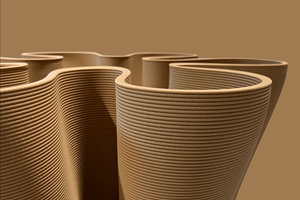Hera Group inaugurates FIB3R recycling plant in Italy
Industrial-scale facility is expected to produce 160 tonnes of rCF/year through pyro-gasification process, supported by cross-sector partners like Leonardo and Angeloni.
FIB3R located in Imola, Italy. Source (All Images) | The Hera Group
(Bologna, Italy), a multi-utility company that operates in the distribution of gas, water, energy and waste disposal, has inaugurated FIB3R, a facility located in Imola, Italy, dedicated to recycling carbon fiber composites on an industrial scale and regenerate it for second use. At present, FIB3R is expected to produce 160 tonnes of recycled carbon fiber (rCF) per year, with 75% energy savings compared to virgin fiber.
The plant’s name reflects the three R’s that stand at the basis of this project: recover, reduce and reuse. Carbon fiber waste will thus be recovered and reused, reducing the use of virgin fiber, and therefore the environmental impact, that would be required to produce it.
Hera Group notes that rCF from FIB3R will retain the virgin fiber’s lightweight and high-strength characteristics through a pyro-gasification process — a combination of pyrolysis and gasification — which is said to enable the rCF to be reused, rewoven and/or impregnated. The number of industrial sectors interested in these features is increasing, ranging from automotive to aerospace, nautical, furniture, textiles and fashion in the broadest sense, to give a few examples.
So far the European Union has allocated more than €2.2 million in financing to enable FIB3R. Total investment planned by Hera Group amounts to €8 million.
“FIB3R aims to promote short and circular supply chains, in line with the strategy of making our served areas more competitive and resilient,” states Orazio Iacono, CEO of the Hera Group. “FIB3R is also a concrete example of how the Hera Group is able to combine technological innovation and sustainability by exploiting the cross-fertilization between the advanced skills of the group’s various sectors.”
According to Iacono, the Hera Group has more than 100 advanced plants and five new facilities under construction to consolidate Europe’s material treatment and recovery. “Our business plan confirms this strategy, with €2 billion in investments for 2024-2028 destined for regenerating resources, a commitment intended to generate value for all our stakeholders.”
The Imola plant was developed by group subsidiary Herambiente (Bologne, Italy), a waste recovery and treatment operator, which has many years of R&D in carbon fiber recovery. This was followed by a collaboration with the University of Bologna’s Department of Industrial Chemistry and its technological partner Curti Costruzioni Meccaniche (Ravenna, Italy), a company specializing in production of automatic machines for industrial applications, which offered its knowledge and pilot plant to model the formula being studied. After 3 years of testing, the Hera Group, based on its expertise in engineering and waste treatment, developed the project and built the FIB3R plant.
To be effective, the Hera Group has formed various partnerships with European entities. This includes the Leonardo Group (Rome), which has already taken up the challenge of applying the circular economy to its production processes. Specifically, Leonardo’s Aerostructures Division will confer to Herambiente part of the composites waste derived from what it uses to construction commercial aircraft — such as the stabilizer of the ATR turboprop, the fuselage and horizontal stabilizer of the Boeing 787 and the tail pieces of the Airbus A220 — which will be sent and recovered at FIB3R.
Herambiente is also partnering up with the Angeloni Group (Venice, Italy) to further build a closed-loop system between the customer, manufacturer and recycler.
Related Content
Plant tour: Airbus, Illescas, Spain
Airbus’ Illescas facility, featuring highly automated composites processes for the A350 lower wing cover and one-piece Section 19 fuselage barrels, works toward production ramp-ups and next-generation aircraft.
Read MoreSulapac introduces Sulapac Flow 1.7 to replace PLA, ABS and PP in FDM, FGF
Available as filament and granules for extrusion, new wood composite matches properties yet is compostable, eliminates microplastics and reduces carbon footprint.
Read MorePlant tour: Teijin Carbon America Inc., Greenwood, S.C., U.S.
In 2018, Teijin broke ground on a facility that is reportedly the largest capacity carbon fiber line currently in existence. The line has been fully functional for nearly two years and has plenty of room for expansion.
Read MoreRevisiting the OceanGate Titan disaster
A year has passed since the tragic loss of the Titan submersible that claimed the lives of five people. What lessons have been learned from the disaster?
Read MoreRead Next
Apply Carbon announces investments, milestones for carbon fiber and aramid recyclability
Financial investments, R&D facility inauguration and an operational solar power plant expands the French company’s product developments, operational recycling capacity and reduce its CO2 footprint.
Read MoreConstruction begins for UMaine sustainability research facility
The Green Engineering and Materials (GEM) building will serve as space for an additive, hybrid manufacturing test bed, future workforce training, and bio-based materials and sustainable technologies development.
Read MoreAngeloni, Herambiente to create closed-loop rCF system, accelerate recycling research
Herambiente recycling facility in Italy and Angeloni’s composites expertise will build a circular system between customer, manufacturer and recycler and further explore rCF opportunities.
Read More












